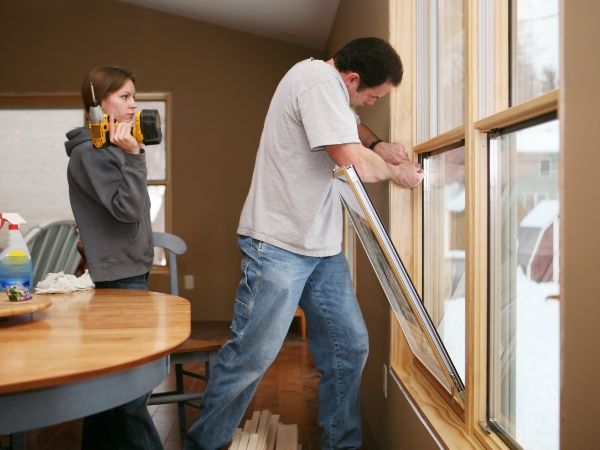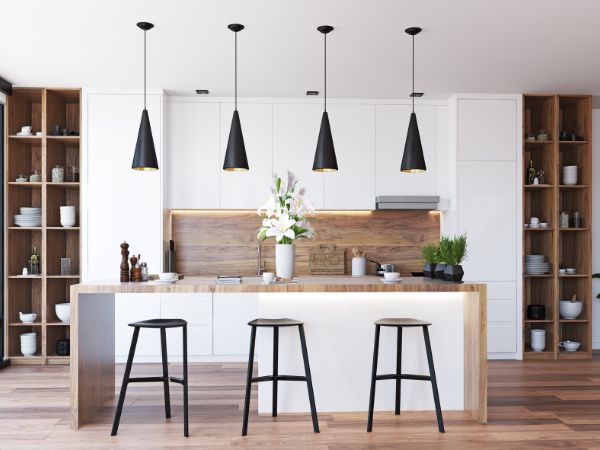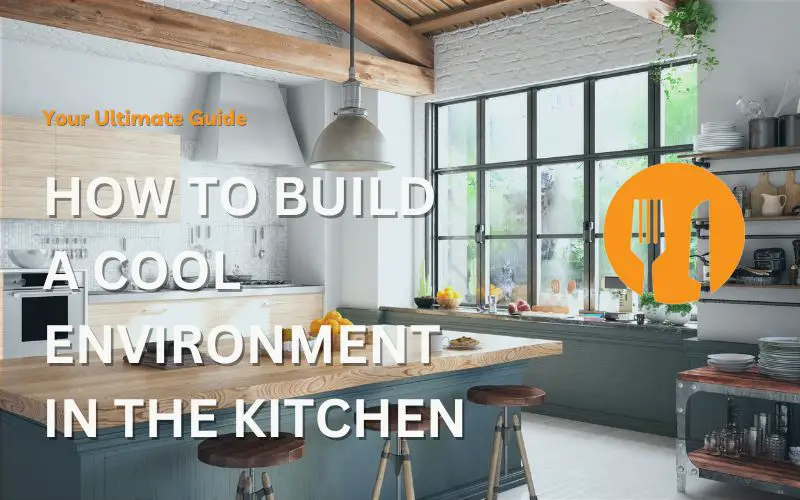How to Build a Cool Environment in the Kitchen? Creating a cool environment in the kitchen is essential for both comfort and efficiency. Knowing which materials and colors to select is key to achieving a space that feels fresh and inviting. I’ll guide you through the choices of natural materials and color palettes that harmonize with the rest of your home, ensuring your kitchen is a pleasant retreat from life’s hustle and bustle.
Natural materials play a pivotal role in not only enhancing the beauty but also in maintaining a steady temperature. Choosing the right elements for your kitchen design can transform it into a cool oasis. Let me share valuable tips on how to leverage these materials for the best results.
Crafting a Fresh and Energy-Efficient Kitchen Space

Smart storage solutions, like bins and baskets, are essential for maintaining an uncluttered and thus cooler kitchen. By keeping everything in its place, air can flow more freely, contributing to a fresher and more energy-efficient space.
The Benefits of a Cool Kitchen
A cool kitchen goes beyond comfort; it’s about efficiency and safety. When air coolers need repair, alternative methods to keep the kitchen cool become crucial. A cool environment reduces the risk of overheating appliances and creates a more pleasant working area, which is especially important in commercial settings.
Embracing Natural Materials for a Cooler Feel
Embracing natural materials like wood and stone, along with maximizing the natural light, can significantly improve the coolness of your kitchen. These materials not only add aesthetic value but also help maintain a constant and pleasant room temperature, making them an ideal choice for any kitchen design.
The Charm of Glass and Painted Ceramic Tile
Integrating glass and painted ceramic tiles into your kitchen design can have a transformative effect. These materials reflect natural light, brightening the space and contributing to a cooler feel. The reflective surfaces bounce light around the room, enhancing the open and airy atmosphere of the kitchen.
Maximizing Air Circulation with Ceiling Fans
Installing ceiling fans is a smart move to improve air circulation and keep the kitchen cool and comfortable. Whether opting for a single fan or a dual setup, the goal is to keep air moving throughout the space, making it more enjoyable to cook and entertain.
Ceiling Fan – The Eco-Friendly Cooling Choice
A ceiling fan is an eco-friendly alternative to an air conditioner, moving cold air throughout the room without the high energy costs. It’s an effective way to maintain a comfortable temperature, reducing the need for energy-intensive cooling methods.
Large Windows: Inviting the Breeze Inside
Installing large windows in your kitchen is a fantastic way to invite the breeze inside. Not only do they allow for a flood of natural light, but they also offer the opportunity to enjoy the view while ensuring that the room stays well-ventilated and cool.
The Central Role of a Kitchen Island in Airflow
A kitchen island is not just a focal point for design but also plays a central role in improving airflow. The placement and design of a kitchen island can significantly affect how air moves around the room, while also providing additional storage space for cooking utensils and ingredients.
Energy Conservation and Eco-Friendly Practices

Adopting energy conservation and eco-friendly practices in the kitchen is not only good for the environment but can also lead to savings on utility bills. Simple adaptations to cooking methods can have a significant impact.
Investing in Energy-Efficient Cooking Appliances
Energy-efficient cooking appliances are a crucial investment for a sustainable kitchen. By choosing appliances that use less energy, you can reduce your carbon footprint and save on energy costs.
Induction Cooktops and Their Benefits
Induction cooktops are an excellent choice for energy-efficient cooking. They work well with stainless steel and cast iron cookware, heating up quickly and offering precise temperature control, which can lead to less energy usage and faster cooking times.
Green Cleaning: The Importance of Regular Utensil Maintenance
Maintaining kitchen utensils with regular cleaning is key to green living. By doing so, you minimize the need for replacement, reduce waste, and can avoid the use of toxic chemicals, contributing to a healthier environment in your kitchen.
Cooking Smart: Energy-Efficient Techniques and Appliances
Smart cooking involves the use of energy-efficient cooking appliances, like toaster ovens, which can make a big difference in energy conservation. Implementing food safety practices, organizing dry goods, and exploring innovative kitchen storage ideas also contribute to an eco-friendly kitchen.
The Impact of Using Pressure Cookers and Solar Ovens
Using pressure cookers and solar ovens can significantly reduce energy consumption in the kitchen. Pressure cookers cook food faster by building up steam, and solar ovens harness the power of the sun, offering an environmentally friendly way to prepare meals.
Implementing a Robust Recycling System in Your Kitchen
I understand the importance of creating an eco-friendly kitchen, one that not only conserves energy but also minimizes waste. Implementing a robust recycling system is a vital step towards this goal. I start by setting up clearly labeled bins for different types of waste – one for paper, one for plastics, and another for glass and metals. I also make it a habit to clean and sort recyclables before disposing of them, ensuring that kitchen cleaning practices contribute to an efficient recycling process. This not only helps in reducing the amount of waste but also lessens the emission of greenhouse gases associated with landfills.
Sustainable Cooking Habits
Adopting sustainable cooking habits has been a game-changer for me. I focus on using pots and pans made from sustainable materials, and I ensure they’re maintained well to extend their life. I also prioritize using energy-efficient appliances and techniques, like covering pots and pans to boil water faster, which helps conserve energy. I’ve found that small changes, like unplugging appliances when not in use, can make a significant difference in reducing my kitchen’s energy consumption, aligning my cooking practices with my eco-friendly kitchen philosophy.
Choosing Long-Lasting Cookware and Energy Smart Stoves
In my kitchen, I opt for cookware that withstands the test of time, reducing the need for frequent replacements. Sustainable materials are my go-to for pots and pans, as they are durable and better for the environment. When it comes to cooking, my electric stove is a cornerstone of energy efficiency. It heats up quickly and offers precise temperature control, helping me save energy and reduce my carbon footprint. I’m always on the lookout for smart, energy-saving appliances that align with my commitment to sustainability.
Local Ingredients and Bulk Purchases: Reducing Food Miles
I take pride in sourcing local ingredients, which helps in cutting down millions of metric tons of greenhouse gases emitted during transportation. By choosing products with a shorter journey from farm to my table, I’m reducing carbon dioxide emissions. I also make bulk purchases of staples with a long shelf life, which minimizes packaging waste and further reduces food miles. Using kitchen towels instead of paper towels is another small step I take towards sustainability, as it reduces waste and the demand for disposable paper products.
Zero-Waste Cooking: Minimizing Kitchen Scraps
Zero-waste cooking is a cornerstone of my kitchen habits. I make it a point to use every part of the ingredients I have, turning peels and scraps into stocks or compost, thus minimizing waste. By planning meals and using leftovers creatively, I avoid unnecessary food waste. This approach not only helps keep my kitchen cool by reducing the amount of waste that could decompose and generate heat, but it also aligns with my eco-friendly values and contributes to a healthier planet.
Design Choices That Enhance Kitchen Coolness

My kitchen is not just a place for cooking; it’s a cool oasis where design and functionality meet. The choices I make, from the layout to the materials, are all about enhancing the coolness and comfort of the space.
Strategic Kitchen Layout for Smooth Workflow
A well-thought-out layout is essential for a smooth workflow in my kitchen. This means considering the placement of appliances and ensuring there’s enough space for me to move around comfortably. By keeping the kitchen organized and free of clutter, I maintain a cool and stress-free environment that’s conducive to cooking and entertaining.
Designing Wide Walkways and Efficient Traffic Flow
To keep my kitchen cool and comfortable, I’ve designed wide walkways to prevent overcrowding. The efficient traffic flow around the kitchen island and kitchen cabinets ensures that I can move around easily, reducing the stress and heat that comes with a cramped space. By maintaining a spacious layout, I ensure that air circulates freely, contributing to a cooler and more inviting kitchen environment.
Color Selection: Light Hues for a Spacious and Cool Ambiance
I’ve chosen light hues for my kitchen cabinets to create a spacious and cool ambiance. These colors reflect natural light, making the space feel open and airy. I’ve complemented these choices with simple window treatments that allow for plenty of natural light, enhancing the coolness of the kitchen. During a kitchen renovation, I always consider how color schemes can influence the temperature and feel of the room.
Smart Storage Solutions to De-clutter and Cool Down
Smart storage solutions are key to keeping my kitchen cool. By utilizing clever organization systems, I de-clutter countertops and ensure that everything has its place. This not only makes my kitchen more functional but also helps maintain a cool temperature. With an efficient HVAC system, I can control the climate of the kitchen, making it a pleasant place to cook and gather, no matter the weather outside.
Conclusion: Achieving a Cool Kitchen Oasis
How to Build a Cool Environment in the Kitchen
Transforming your kitchen into a cool oasis is a blend of smart design and sustainable practices. By organizing your pantry, you can ensure that heat rises without obstruction, maintaining a kitchen cool even during peak food preparation. Strategic placement of countertop appliances away from electrical outlets that generate excessive heat can help maintain energy efficiency, while a thoughtful kitchen layout contributes to a fluid workflow. Thoughtful touches like a magnetic strip for cooking essentials or fun coffee mugs displayed on cabinet doors add personality without cluttering counter space.
Embracing eco-friendly habits reduces both energy costs and your carbon footprint in the kitchen. Store food scraps for compost rather than waste, and choose energy star-rated appliances for optimal energy efficiency. Meal preparation becomes a breeze with everything in its right place, from frozen foods and organic foods in food storage to canned goods within easy reach. Remember that simple changes, like using recycled paper grocery bags or reducing the use of coffee grounds, can make a significant impact. As you implement these tips, you’ll find that your kitchen isn’t just cooler—it’s also a more enjoyable space for creating delicious memories.
Spread the joy with others

Written By Jeanette Wilson
Jeanette Wilson has spent the last 12+ years designing, testing, and improving kitchen gadgets and appliances. She also knows her way around a home and professional kitchen, as she is a passionate home cook and runs her own roadside eatery.